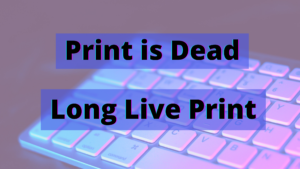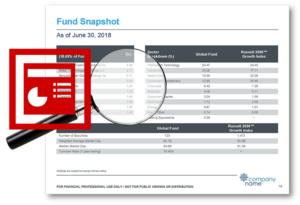8 Pitchbook Pain Points for Marketers
Creating and maintaining pitchbooks can be the bane of a marketing team’s existence. Product managers are always finding new ways to spin or illustrate their products. Sales teams and firm partners are always insisting that one more chart or illustration is absolutely critical to their pitch. And of course, there is the simple drudgery of making sure the standard data, disclosures, and charts are up-to-date and refreshed on time.
Pitchbooks are vital to the sales effort. So, naturally, salespeople are eager to get their hands on these materials as soon as possible after quarter-end. They expect the information to be current and compliant, and they want a simple and organized way to access the slides so they can develop an impressive pitch. Not only do marketers spend a substantial amount of time keeping their slide libraries up-to-date, but they are often challenged to keep up with customization requests by the sales team.
The efficacy of these pitch decks is vital to closing deals, which means most salespeople want presentations that are highly client-centric. To get customized pitchbooks out in a timely fashion, it’s important for the marketing team to have a turnkey strategy for creating custom decks.
For most marketers, nailing-down a process to support these goals is easier said than done. Most firms don’t have a good strategy in place, which causes many of these common pitchbook management woes:
1) Sorry honey, I won’t be home for dinner tonight.
Updating slides every quarter is not only maddening, it’s a total time sink. Depending on the number of slides in your library, this is not a quick and simple task. Making manual updates may have been manageable when there were just some standard decks for 10 or 15 products, but as your product line has grown and the number of slides in your decks has expanded, the time required to complete this effort can be substantial. Nobody wants to be updating and QA’ing pitchbooks until midnight. The negative effect of this time-sink is that the person doing the updates is probably being pulled-away from more strategic projects that require human innovation, not to mention it’s probably making them unhappy at work. At some point it’s probably wiser to automate the tedious updates and use your human talent to drive your strategy. It’s up to you to decide when you reach that tipping point.
2) Compliance roulette anyone?
Finding and updating all the slides impacted by changes in data or disclosure is like playing compliance roulette. Unless you have extremely good controls in place, updating a high volume of slides is risky. Your “controls” may involve time-intensive rounds of review and QA between marketers, designers, and compliance officers (please see #1 above), but the truth is that no matter how many eyeballs land on the materials, the element of human error is inevitable. Accidents happen; we are fallible. But publishing the wrong data point or disclosure in a pitchbook is embarrassing and creates liabilities. Prospects and clients don’t appreciate errors. If you can’t get the numbers in your pitchbooks right, how will you get their investment strategy right?
3) Only Jennifer knows where that slide comes from.
It’s very common for a marketing team to have a “point person” for creating and updating pitchbooks. PowerPoint slides are managed by “Jennifer” and often kept all in one folder of single-slide PPT files on a shared LAN drive. Or maybe they are kept in master decks or modules stored in static folders in SharePoint where, supposedly, everyone (including the sales team) can find them when they need them.
In either scenario, only Jennifer really knows the structure and origin of the materials. And, if asked to find all the slides mentioning currency risk or every slide with an expense ratio on it, there’s about an 80% chance that she will find them all. This scenario works great until Jennifer goes on vacation or takes an extended leave of absence. Not only are you one man down, but she took her pitchbook knowledge with her, leaving everyone in frenzy.
4) Um…is anyone still using this slide?
Slide deck materials are similar to disclosure language; people love to add more content, but seldom take any away. The tendency is to take the attitude, “it’s not hurting anything to keep it in here, and if we remove it someone will turn up asking for it. So, let’s just leave it in”.
This approach seems great in theory, but over time your slide library could reach a ridiculous scale, and continue to grow until somebody finally says, “Do we actually need all of these slides?” If your current process provides little to no insight into how often each deck or slide is used, it’s hard to know if it’s even worth updating and/or keeping certain slides. Ideally, you should be able to measure the usage and efficacy of each slide. And, be able to re-work slides or modules without doing a complete dump of the material.
A refresh of your entire pitchbook strategy means consulting with people from Compliance and Sales on the validity and efficacy of the materials. In turn, they are pulled away from other things they could be doing. This is counterproductive.
5) Is this even the right version of this slide?
If you’re one of the few well-organized firms whose pitchbook strategy takes into consideration version control, effective dates, sunrise and sunset dates, where-used reports, and a thorough audit trail of material sources and uses – congratulations! It’s not an easy project for marketing and IT to bite-off. One of the major problems with managing presentation materials is making sure that there is a central repository where the slides live that has a good system in place in case an audit needs to be done. Can you pull up past versions of slides? Do you know who was responsible for the changes made on all of your current and previous versions of slides? If FINRA or the SEC want to know, you had better be able to show and tell them. Even if there are errors or omissions, you need to be able to establish a thoughtful process and good record keeping for your communication efforts. That is half the battle.
6) Custom pitchbooks, oh joy!
Ah, custom pitchbooks. Talk about the bane of a marketer’s existence. In order for custom pitchbooks to be truly effective, marketers really need insight from the salesforce. What are the client’s goals? Where are they in the sales process? How much information do they need about the firm vs. the products? And while salespeople are famous for insisting that this task is “marketing’s job” it really is a job more suited for sales, with proper controls put in place by marketing and compliance. Marketing’s main job should be creating material and devising programs that speak to broad audiences; things that build brand awareness and interest in the firm’s products or services. Planning and conducting individual sales activities should usually be in the domain of the sales group.
While in some cases and some organizations, marketing may be more closely tied to individual sales efforts, my observation is that in many cases this role distinction isn’t even possible because the tools and rules to allow the sales group to operate more independently do not exist or are not easy enough to use.
7) Waiting for that ‘crazy data’.
A few months ago, I asked an investment marketer to explain the process of getting the data she needs to start updating their marketing materials. Almost verbatim, she said, “We wait and wait and wait for the data to come and when it finally comes, it’s crazy data.” She explained that not only does it take too long for the data to get to the marketing group, but once it arrives there problems with it. This is a pain-point we hear over and over again: that the data is the real bottleneck of the operation. When your data is being used to personalize a pitchbook for a client or prospect, the last thing you want is crazy data. Taking crazy data out on the street is risky and it makes you look bad. Taking the time to fix this crazy data affects your turnaround times and is generally annoying. Immediate access to quality data is the key to most if not all of an investment marketer’s dreams. If you can get to a point where your data is your “one source of truth”, maintaining accurate and consistent information across your marketing and sales materials will be painless. And using automation to refresh your slides immediately upon receipt of this clean and accurate data is a game-changer for everyone involved in the pitchbook process.
8) The info on your slides doesn’t match your website.
It’s not uncommon for presentation materials to be slightly out of sync with other materials provided by the firm. (Remember when PIMCO had to yank their Total Return disclosures from their public web page?) While inconsistencies may just be a matter of rounding, this can still be risky when viewed from a compliance perspective. Excel, Java, and Oracle can round numbers differently unless you take care to program your preference. To reiterate #7 above, data quality is a big deal. Unless your slide materials are being updated by a direct data feed from your systems of record, the chances of the data in the slides being out of date, or not matching the web site can increase substantially.
Conclusion
Creating pitchbooks and keeping them up-to-date can be a painful process. Ad-hoc customization requests are a huge part of this. Making sure your presentation materials are accurate and effective is a constant battle. But, it’s a battle that must be won in order to attract and retain clients. To effectively manage the resources, risks, and results associated with your pitchbook strategy, it may be time to invest in a pitchbook automation tool.
What other pain-points or problems does your marketing team run into with pitchbook updates or overall strategy? I’d love to hear from you. Feel free to send me a note at [email protected].
Did you like this post? Please share! You can also subscribe to our blog.
Here are some related resources that might interest you: From the Blog: Print is Dead, Long Live Print! |  From the Blog: Why Pitch Decks Should be Created by Sales, Not Marketing |  From the Blog: Obstacles Salespeople Face when Trying to be Customer-Centric |





 Compare the Top 3 Finserv Content Automation Vendors [White paper]
Compare the Top 3 Finserv Content Automation Vendors [White paper] Create Pitchbooks the Drive Sales [White paper]
Create Pitchbooks the Drive Sales [White paper] Build vs. Buy: Should Your Financial Services Firm Outsource or Insource Marketing Technology? [White paper]
Build vs. Buy: Should Your Financial Services Firm Outsource or Insource Marketing Technology? [White paper]  10 Tips for Rebranding your Fund Marketing Documents [White paper]
10 Tips for Rebranding your Fund Marketing Documents [White paper]




